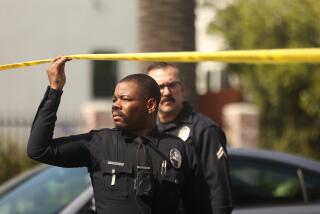When states have strong gun laws, they also have fewer fatal police shootings
Fatal shootings of civilians by police officers are less common in states with stricter gun laws than they are in states that take a more relaxed approach to regulating the sale, storage and use of firearms, new research says.
A study published Thursday in the American Journal of Public Health has found that fatal police shootings were about half as common in states whose gun laws place them in the top 25% of stringency than they were in states where such restrictions ranked in the bottom 25%.
The new findings draw from an analysis of 1,835 firearms-related deaths involving a police officer in the United States — all such fatalities reported in the 22 months following Jan. 1, 2015. It found that, of 42 laws enacted by states, the ones most strongly linked to lower fatal police shootings were those that aimed to strengthen background checks, to promote safe firearm storage, and to reduce gun trafficking.
“We suspect that because these states have more robust gun laws, they’re better able to keep guns out of the hands of the wrong people,” said the study’s lead author, University of Indianapolis psychology professor Aaron Kivisto. The likely result, he suggested, is that police in such states “are just less likely to encounter people in circumstances where they shouldn’t have a gun.”
The association held up even after researchers accounted for state differences in the density and demographics of its citizens.
The study results add to a broad pattern of findings about states’ rates of gun ownership, which largely rise and fall along with gun-related suicides, accidental firearm injuries and domestic violence deaths.
New Mexico, Wyoming, Alaska, Oklahoma and Arizona led the country in rates of fatal police shootings, which were calculated as the number of such deaths per 1 million state residents. All but Oklahoma had among the most relaxed gun laws on their books.
Rhode Island, New York, Connecticut, Massachusetts and Illinois were among the states with the lowest rates of officer-involved fatal shootings. All had gun laws that placed them among the nation’s most restrictive states.
But not all states fit the pattern. California was especially unusual, Kivisto said: Though the state claimed the No. 1 position for stringency of gun laws, its rate of fatal police shootings during the study period was much higher than the national average. In fact, the rate of officer-involved gun deaths in California fell between those of South Dakota and Alabama, two states with some of the scantest restrictions on the sale, ownership and use of guns.
Kivisto suggested that for some states, including California, statutory efforts to staunch the supply of guns on the streets were likely being undermined by gun trafficking from neighboring states. Arizona and Nevada have gun laws that are among the nation’s least restrictive (as well as rates of fatal police shooting that are well above the norm).
“A state can have the strongest gun laws possible, but it can’t stop gun from flowing across state boundaries,” Kivisto said. ”One of strongest arguments for federal gun laws would be that some uniformity may be needed to stop guns flowing in from other states.”
Other states bucked the national pattern by maintaining both few gun restrictions and low rates of officer-involved fatal shootings. This group included Maine, North Dakota, New Hampshire and Indiana.
Kivisto and his co-authors did not rely on Justice Department statistics of police-related shootings, since states are not required to report those and don’t necessarily do so routinely. Instead, the researchers relied on a running tally of officer-involved fatalities maintained by the British newspaper The Guardian, a source that is considered comprehensive.
In addition to verifying and chronicling the time, location and circumstances of the shootings, The Guardian’s database, called “The Counted,” also documents the victim’s gender, race or ethnicity, whether he (96% of all victims during the study period were male) was armed, and by what mechanism the victim was killed (for instance, by taser, by firearm or struck by a car).
Of 2,021 fatalities during the 22-month study period, 1,835 were killed with a police officer’s gun. And in 53% of those cases, the person killed was also armed with a gun. One in 10 were thought to be entirely unarmed at the time of the fatal shooting. Individuals from racial or ethnic minority groups made up slightly more than one-third of all victims.
ALSO
Scientists get closer to making personalized blood cells by using patients’ own stem cells
Experts measure food waste not in dollars or tons, but by calories, vitamins and minerals
Rising sea levels could mean twice as much flood risk in Los Angeles and other coastal cities







